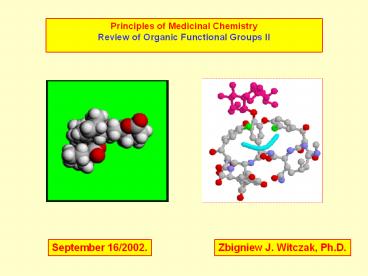Principles of Medicinal Chemistry - PowerPoint PPT Presentation
1 / 20
Title:
Principles of Medicinal Chemistry
Description:
... depends on stability of carboxylate anion which is influenced by electronic ... electron-donating R groups stablize the carbonylate anion and decrease acidity. ... – PowerPoint PPT presentation
Number of Views:1909
Avg rating:3.0/5.0
Title: Principles of Medicinal Chemistry
1
Principles of Medicinal Chemistry Review of
Organic Functional Groups II
September 16/2002.
Zbigniew J. Witczak, Ph.D.
2
Principles of Medicinal Chemistry PHA 421 Dr.
Zbigniew J. Witczak
- Learning Objectives
- After completion of theses lectures students
should be able to - Predict the effect on water solubility of various
functional groups within a drug molecule. - Should be able to describe hoe the structures of
drug molecules influence their pharmacological
activity. - Should be able to explain the principle of
bioisosterism and be able to modify drug
molecules using this principles. - Should be able to relate the principle of
pharmacophore and how it is used to develop new
drugs.
3
Important Functional Groups on Drugs II
1.Phenols Metabolism
Metabolic Reactions of the Phenol Functional
Groups
4
1.Ether Metabolism
Metabolic dealkylation of anisole
5
Aldehydes and Ketones
- Ketones can exist as an equilibrium mixture of
keto- and enol- froms - Carbonyl group is permanently polar and thus can
hydrogen bond with water to exhibit good water
solubility
Minor oxidation of aldehydes
6
Amines
- Primary and secondary amines have weaker dipole
moments than hydroxyl groups thus poorer
hydrogen bonding capacity - The amines do have one pair of unshared
electrons, which is able to provide hydrogen
bonding with water hydrogen and thus reasonable
solubility. - Solubility trends primarygt secondarygt tertiary
- Amines also have basic nature due to
availability of the two unshared electrons on
the nitrogen - Aromatic amines are generally less basic due to
electron-withdrawing nature of phenyl and thus
the unshared electrons are resonance stabilized. - Amines can react with acids to from conjugate
salts which would be water- soluble provided the
conjugate is dissociable. Can from salts with
hydrochloric, sulfuric phosphoric, succinic
citric maleic and tartaric acids. - Addition of base to the conjugate salts will
liberate the free amine which can precipitate
out of solution due to poor water solubility.
Thus bases are chemically incompatible with
amine salts. - Quarternary amines cannot be converted to free
amine by base treatment and positive charge on
the nitrogen allows good ion-dipole interaction
with water and thus exhibit good water
solubility
7
Carboxylic Acids
- Strong hydrogen bonds with water ensure the
solubility of this group - Behave as acids strength depends on stability of
carboxylate anion which is influenced by
electronic character of R group
electron-donating R groups stablize the
carbonylate anion and decrease acidity. The
opposite is true for electron withdrawing
groups due to resonance stablization of the
anion. - Carboxylic acids will r4eact with bases to from
salts that have high water solubility.Chemical
incompatibility of carboxylate salt conjugate
with acids is due to formation of free carboxylic
acid which can precipitate out of solution.
Which group on the compound is most least
acidic.
8
Functional derivatives of Carboxylic Acids
- Esters
- Similar physicochemical properties to ethers is
a combination of - polar alcohol and polar acid to produce less
polar ester due to lack - of hydroxyl groups.
- Can be hydrolyzed by acid or base to an alcohol
and acid - Esters are incompatible with strong bases due to
above reaction
- B. Amides
- Amides results from a polar carboxylic acid and
weakly polar primary or - secondary amine or ammonia have reasonable
solubility due to - hydrogen bonding and ion-dipole interactions.
- Amides are more stable to acid/base hydrolysis
than esters but are - also more neutral than basic and thus being
unable to from acid salts.
9
Structure Activity Relationships in Drug Action
- Pharmacological agents generally mimic the
structural properties of - endogenous substances
10
Neurotransmitters
R H, Noradrenaline R Me Adrenaline
Dopamine
Serotonine
3-hydroxytryptamine
Glycine
Acetylocholine
g-aminobutiric acid (GABA)
11
Structures of Clinically Useful Sulfonamides
Sulfacytine
Sulfadiazine
Sulfamethizole
R
R pKa 5.45
R pKa 6.9
Sulfamethazine
Sulfamerazine
Sulfamethoxazole
R
R
R
12
Schematic Actions of Sulfonamides and Trimethoprim
13
How prodrugs are made
14
(No Transcript)
15
(No Transcript)
16
Chemical Delivery Systems Pharmacologically
inactive molecules that require several steps of
chemical and/or enzymatic conversion to the
active drug and enhance drug delivery to
particular organs or sites. Example
Brain-specific chemical delivery system
17
(No Transcript)
18
New approaches
Soft Drugs Biologically active, therapeutically
useful chemical molecules (drugs) characterized
by a predictable and controllable in vivo
deactivation, after achieving the therapeutic
objective, to nontoxic, inactive compounds
19
Examples
2. Improving drug delivery The pro-drug by its
improved characteristics gets closer to the
receptor site for a longer period of time, and
conversion to the parent drug takes place at the
site of action.
20
(No Transcript)































